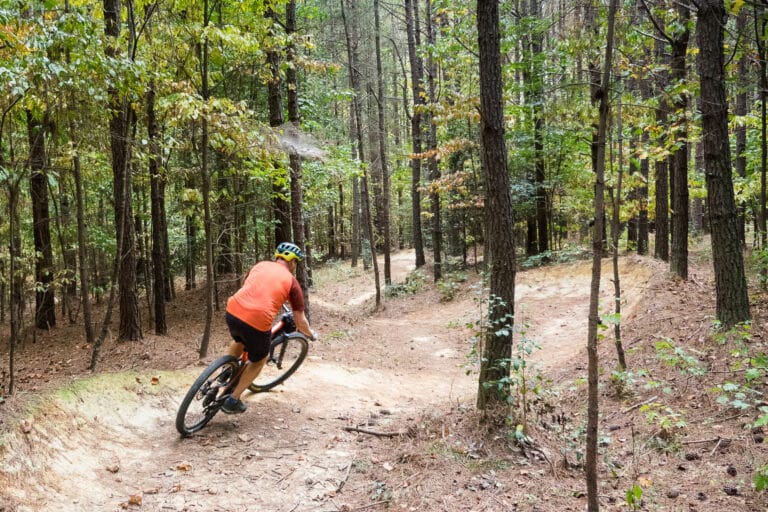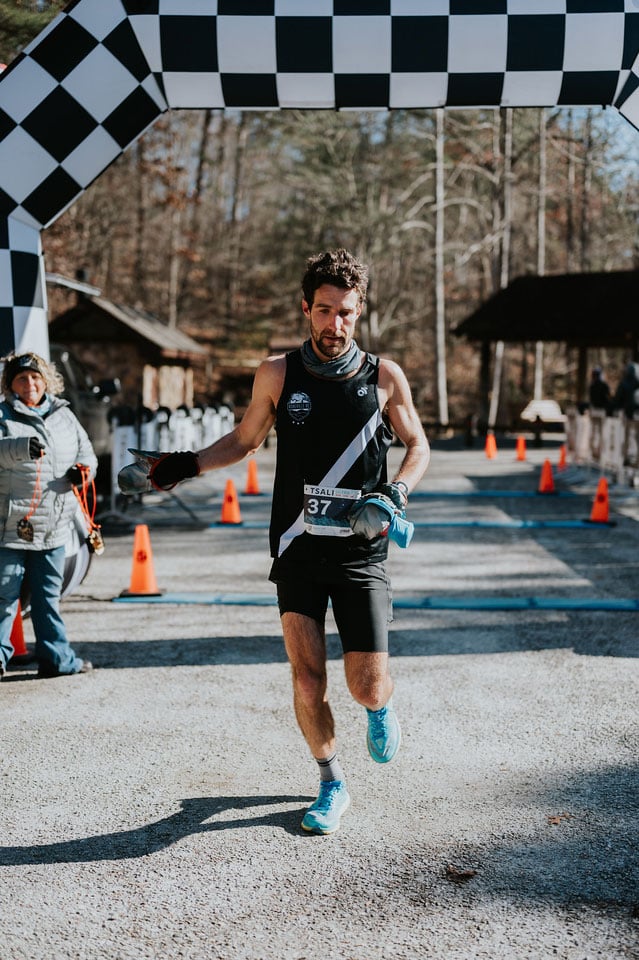“You’re not going to use our real names, are you?” Sarah Palin asks as she hands me a plastic cup of beer from the keg.

She’s not the real Sarah Palin. She’s just dressed as the moose-shooting governor of Alaska. By my count, there are three Sarah Palins here tonight. One Robin (no Batman), two Mexican wrestlers, one Zorro, an angel, a cheerleader, and about a dozen costumes I don’t understand. I spent half the night running behind a woman wearing a shower cap, silk bathrobe, and maybe nothing else. Currently, we’re all sandwiched onto a skinny front porch drinking beer, eating M&Ms, and singing a song about contracting syphilis.
This is the scene for the Asheville Hash House Harriers (AH3) annual Hallow Hash after party. Earlier, a group of grown men and women dressed in costume ran five miles through a well-to-do neighborhood, drinking beer along the way. It sounds strange, but all across the globe, thousands of adults practice this same tradition, sometimes on a weekly basis. It’s called hashing, and it’s a cross between a training run and a fraternity keg party. Miles are run, women are offended, beer is consumed, and light hazing occurs.
Hashes are organized differently throughout the world, but a few basic principles are consistent whether you’re in Pittsburgh or Phuket. A lead runner, called a hare, sets a trail with flour or chalk. The other runners, called harriers, follow the flour trail trying to track the hare down, yelling “On On” whenever they see the marks of flour. Along the way there are false trails, dead-ends, and hidden stashes of cold beer. Each hash ends with the ultimate reward: a massive celebration known as the “On After” where more beer is consumed and songs are sung—most of which have to do with sexual acts or venereal diseases.
These basic hashing principles have been in place since hashing was created in the early 1900s by a group of British ex-pats living in Malaysia. The Englishmen were bored, so they started a running club. They got bored with running, so they started drinking while they ran. From such humble origins, a fervent pastime grew. According to the World Hash House Harriers Database Project, just about every major city in the world has a hash club. There are three hash clubs in Afghanistan, and one in the Republic of Congo.
Ralph, a very tall, blonde German who chose to wear a bathrobe and a jockstrap for AH3’s Hallow Hash, sums up hashing’s international appeal with his thick accent: “I like to run and I like beer.” The Hallow Hash starts in the parking lot of a running shop on the north side of town. Dr. Doolittle, the grand master of the Asheville Hash House Harriers, pops his hatchback to reveal two full coolers of really, really cheap beer. Dr. Doolittle is a real doctor and competitive runner. Tonight, he’s also a Mexican wrestler.
The duality of veteran hashers is intriguing. Hashers are normal people. They’re doctors, lawyers, bus drivers, stay-at-home moms, wedding photographers, social workers—normal people with normal lives who occasionally come together to call each other dirty names, sing songs about vaginas and penises, drink lots of beer, and run. It’s as if on hash night, these otherwise responsible adults get to indulge in their “doppelgangers”—crass alter egos with nothing on their minds but sex, booze, and cardiovascular exercise.
It’s no wonder Sarah Palin didn’t want me to use her real name in this story.
Dirk Dickless, AH3’s Spiritual Advisor, spends a lot of time trying to encourage other runners in Western North Carolina to indulge in their baser instincts. AH3 is a relatively new group with only a handful of organized hashes under their belt and relatively low numbers compared to other hashes.
“I lived in San Francisco and there was a hash every week,” Dirk says. He’s dressed as a plumber— but not the kind that comes to fix your toilet—the kind you see in porn movies. “We can only manage one every few months because we don’t have enough members to help organize. Eventually, we’d like to get to the point where we’re hashing every week, with rotating hares.”
This particular Hallow Hash has drawn an impressive crowd, and most of the runners are hash virgins, suggesting that maybe there is a market for athletic debauchery in this mountain town. Some of the most enthusiastically costumed runners are also hash virgins, as if they’ve been waiting for an excuse to dress up like a shepherd or bar wench and run five miles and drink several beers.
After some basic instructions are given to the group of costumed runners, one Mexican wrestler and one Sarah Palin run off into the darkness to set the first leg of the trail. Gatorhater, a visiting hasher from Raleigh with an encyclopedic knowledge of bawdy hashing songs, leads the group of harriers in a round of inspirational sing-a-longs while we give the hares a ten-minute head start. After about four minutes, we decide the ten-minute head start is up and we start running into a neighborhood, headlamps on, looking for patches of white flour on the streets.
Dirk Dickless, an elite runner who finishes at the front of most local races when he’s not dressed as a porn plumber, leads the way searching for the elusive white dots. There are several solid runners in the group, so the pace is a little quicker than most hashes, which traditionally attract more recreational joggers than competitive runners. We run through a park and dodge several cars when crossing through a neighborhood, all the while listening to the front runners yell “on on” whenever they see a solid flour trail. At one point, the trail splits and two runners venture off in opposite directions looking to see which trail is legit and which is false. In less than a mile, we see a white “B/N” spelled in flour in the middle of the street. There are a number of hash symbols that hares decorate a course with, but “B/N” is the most special of all. It means “Beer Near.” A group of us pause at the “B/N” symbol and spread out in different directions searching the yards of the affluent neighborhood for coolers of beer. In a matter of seconds, one of the veteran hashers has sniffed out the stash and yells “Beer Here!”
There are three “Beer Here” spots staged throughout the five-mile course, which climbs a total of 3,700 feet in elevation through parks, neighborhoods, and one private golf course. For each leg of the course, we run a couple of miles, searching out the flour signs, then convene on a patch of lawn near a “B/N” symbol to drink beer and eat pretzels before starting the process over again. We move in a big group of costumes, progressively getting more boisterous with every “Beer Here.”
At the On After, crimes must be punished. Hashers keep tabs on each other throughout the run, tracking various slights that need to be punished with mandatory beer guzzles. A virgin hasher is forced to chug half a beer for refusing to drink beer from a trashcan while running. Dr. Doolittle is punished for dropping his pants while running on the golf course. For each crime, a song is sung, usually about how the criminal is a degenerate.
I’m punished for pretending to write an article about hashing. While I down my beer, the entire crowd sings a song about how much of an a-hole I am. And I love every second of it.
The Cheddarhead
There’s hashing, and then there’s the Cheddarhead, which could be the most creative hash in the Southeast. Take your standard run, drink, run, drink afternoon and throw in nearly 200 participants, 60 pounds of fried cheese curds, polka music, bowling, bratwurst, and more beer. BRO talked with the Cheddarhead’s original founders, Dave Paul and Derald Loomis, about the art of cooking cheese curds, light public nudity, and their obsession with running and drinking.
How was the Cheddarhead conceived?
Hashers as a group are very irreverent. It’s such a peculiar sport or lifestyle. You’ll only find a certain number of people who want to run through the woods, hollering, drinking, and getting bloody. Irreverence is a key aspect of hashing, so we wanted to play on the New Year’s resolution. Everyone wants to be healthy in the New Year, so we went in the opposite direction. We eat as much high fat food as possible and drink as much beer as possible. I mean, how ridiculous is it to eat cheese curds and run? I love it.
What is a cheese curd?
It’s made during a process that involves separating milk into whey and blobs of curd cheese. They’re little blocks of cholesterol. People who worked in the Wisconsin cheese factories used to bag these little blocks up and take them to their local pub and eat them as a snack. We have 50 or 60 pounds of them shipped down for the run. They come right off the line, so they’re really fresh. If they’re not fresh, they’re not good. Of course, we fry them in a deep fat fryer.
Has the Cheddarhead grown over the years?
The Cheddarhead started with 40 or 50 people. It was a very manageable group. Now, we get about 200 people, and Johnsonville Brats came on as a sponsor this year. They heard about the run, liked the idea, and gave us a whole bunch of brats. It’s definitely a big deal now, with all the cooking, and the logistics. Last year, we had 176 runners even in the cold weather. That’s the power of cheese.
——









